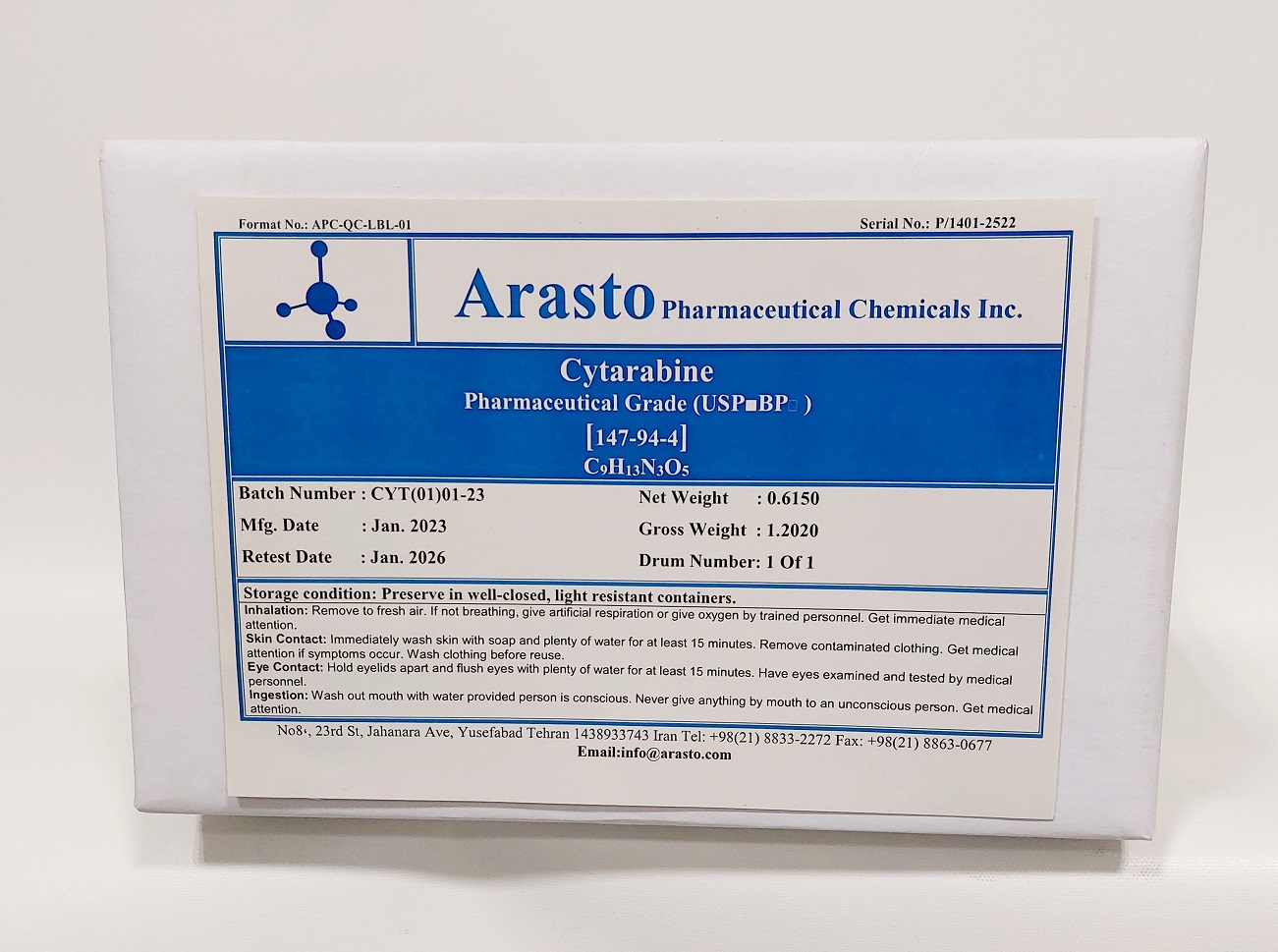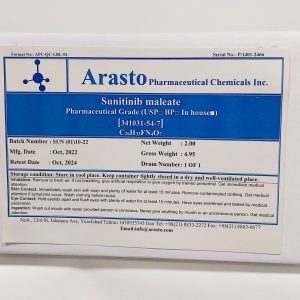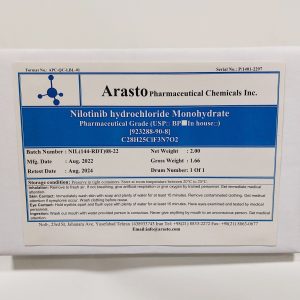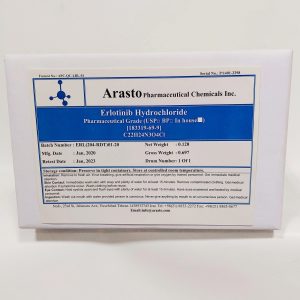Description
Description
(USP 44)
- Drug Substance General Information (ICH 3.2.S.1)
1.1. Nomenclature (ICH 3.2.S.1.1)
International non-proprietary name: Cytarabine (Brand Name: Cytosar, Pfizer, USA)
Compendial name: Cytarabine
Chemical name: 4-amino-1-[(2R,3S,4R,5R)-3,4-dihydroxy-5- (hydroxymethyl)oxolan-2-yl] pyrimidin-2-one
Arasto’s code: CYT
CAS Registry Number: [147-94-4]
- Drug Substance General Information (ICH 3.2.S.1)
1.2 Structure (ICH 3.2.S.1.2)

Molecular Weight: 243.217 g/mol
- Drug Substance General Information (ICH 3.2.S.1)
1.3. General Properties (ICH 3.2.S.1.3)
Cytarabine is a white crystalline substance. It is soluble in neutral water and partially soluble in very polar organic solvents such as DMSO. Cytarabine is used in injectable form in combination with other approved anti-cancer drugs for the treatment of non-lymphocytic leukemia, acute lymphocytic leukemia, chronic myelocytic leukemia and its intrathecal administration indicated in the prophylaxis and treatment of meningeal leukemia (http://patient.cancerconsultants.com/druginserts/Cytarabine.pdf). In .The pKa of cytarabine has been reported to be 4.3 (http://www. ncbi.nlm.nih.gov/pmc/articles/PMC2754920/). LD50 of cytarabine has been reported (>5000 mg/kg, oral, rat http://www.bdipharma.com/ MSDS/Hospira/Cytarabine.pdf)
The determination of purity and assay of APIs require comparison of the product with their respective Reference Standards (RS) and Related Compounds (RC or known impurities). Accordingly, ICH regulations on the purity and assay of reference standard and related compounds are clearly defined and must be followed by drug substance and drug product manufacturers.
According to ICH Q7, 11.1 there are 3 types of standards. This is summarized in the following chart and discussed in detail below.

The impurities provided in the following table represent Secondary Reference Standards (SRS) that are prepared in-house by synthesis or by isolation. Each SRS has undergone extensive characterization ( IR, UV, 1HNMR, 13CNMR. Mass Spec) and determination of its purity and assay (HPLC). For specification of the SRS of those products that have a monograph, the SRS is compared with a pharmacopoeia Primary Reference Standard (UV, HPLC retention time). For specification of those products that do not have a monograph (known as House Primary Standard), we compare their UV ε or ג /max , IR major absorptions, 1HNMR d (ppm) , 13 CNMR d (ppm) or HPLC retention time with values reported in the chemical literature for these compounds.

5. Primary and Secondary Reference Standard (ICH 3.2.S.5)
5.1. Active Pharmaceutical Ingredient
Primary Reference Standard for cytarabine is available from United States Pharmacopoeia. We will use a Secondary Reference Standard (previously referred to as Working Standard) for direct control of all batches of cytarabine.
As per ICH (Q7, 11.1) and ICH (Q6, 2.11, 3.2, 3.3)the Secondary Reference Standards, which include the API and its Related Compounds, must be examined for their proof of structure (characterization), assay and purity and specification (identification by comparison). Furthermore, ICH Guideline on the Preparation of Common Technical Document (Q4M) requires that the data obtained from characterization, assay and purity and specification must be included in section 3.2.S.3.2 for Related Compounds (already discussed in that section) and section 3.2.S.5 of the DMF for the API. To this end, the Secondary Reference Standards of the API cytarabine has undergone extensive characterization (UV, IR, 1 H NMR, 13C NMR, and Mass Spec) to assure its structure, assay and purity (HPLC and/or titration) and specification (comparison of its HPLC retention time and UV ג /max with USP Primary Reference Standard.
The Secondary Reference Standard for cytarabine was produced from a released batch of cytarabine by subjecting it to an additional crystallization from the final solvent system used in the production of the API to avoid the possibility of other polymorph formation.
SPECIFICATION OF ANALYSIS
| Product: Cytarabine | CAS No.: 147-94-4 | Spec. No.: APC-QC-SPEC-333-00 | ||
| Issue Date: Apr, 2023 | Valid up to: Apr, 2024 | Reference: USP44 | ||
| Tests | Specifications | |||
| Description | Odorless, white to off-white, crystalline powder. | |||
| Solubility | Freely Soluble in water; slightly soluble in alcohol and in chloroform. | |||
| Identification | A: Infrared Spectroscopy B: The retention time of the major peak of the sample solution corresponds to that of the standard solution, As obtained in the assay. | |||
| Specific rotation | +154° to +160° | |||
| Loss on drying | NMT 1.0% | |||
| Residue on ignition | NMT 0.5% | |||
| Residual Solvent | Methanol: Max 3000ppm (Class II) Acetone: Max 5000ppm (Class III) Dimethylformamide: Max 880ppm (Class II) | |||
| Organic Impurities (HPLC) | Cyclocytidine: NMT 0.10% Cytosine: NMT 0.10% Uracil: NMT 0.10% Uridine: NMT 0.10% Uracil arabinoside: NMT 0.30% Any individual unspecified impurity: NMT 0.10% Total impurities: NMT 0.30% | |||
| Assay (HPLC) | 98.0% to 102.0% (on the dried basis) | |||
| Microbial limit test(MLT) Total aerobic Microbial count Total yeast and molds count Test of pathogen 1. E. Coli 2. P.aeruginosa 3. Salmonella species 4. S.aureus Endotoxin Limit | NMT 1000 CFU/g NMT 100 CFU/g Should be Absent Should be Absent Should be Absent Should be Absent NMT 0.07 Units/mg | |||
| Prepared by: M. Shahbazi, B.Sc.Chem. | Checked by: A. Forghani, B.Sc.Chem. | |||
| Approved by: F. Javadizadeh, M.Sc.Chem. | ||||
| Storage: Preserve in well-closed, light resistant containers. | ||||





